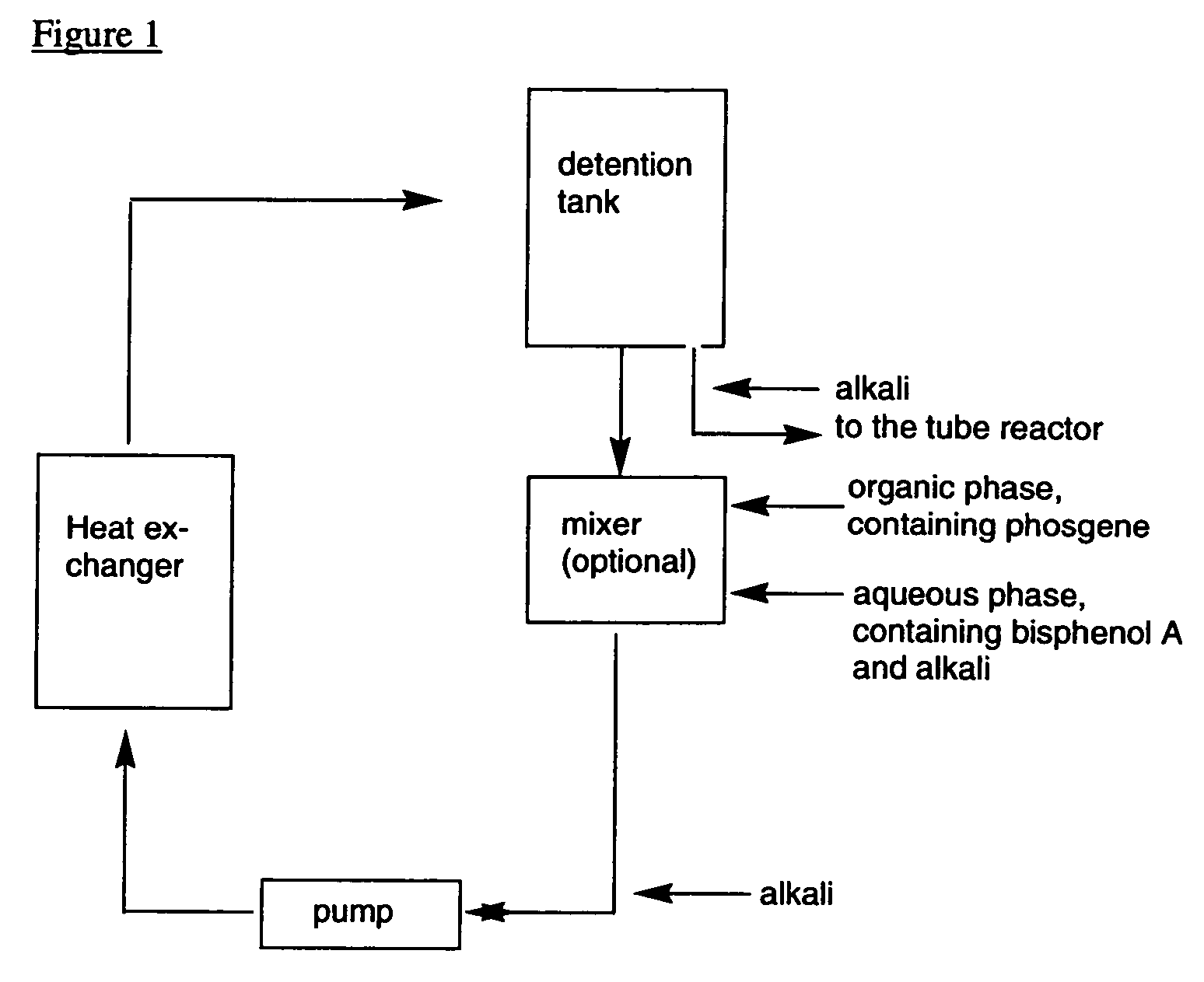Process for the preparation of polycarbonates
a technology of polycarbonate and polycarbonate, which is applied in the direction of fluid leakage detection, fluid tightness measurement, instruments, etc., can solve the problems of no doctrine at all, adverse influence, and only an indication of critical nitrogen conten
- Summary
- Abstract
- Description
- Claims
- Application Information
AI Technical Summary
Benefits of technology
Problems solved by technology
Method used
Image
Examples
example 1
[0090]Via a T-piece, before the pump, 24,000 kg / h of an alkaline bisphenol A solution which contains 15 wt. % BPA and 2.1 mol of sodium hydroxide solution per mol of BPA and, via a further T-piece, 1,840 kg / h of phosgene dissolved in 21,000 kg / h of solvent, which consists of 50 wt. % methylene chloride and 50 wt. % monochlorobenzene, are metered into a loop reactor.
[0091]To maintain the alkalinity, 348 kg / h of 32% sodium hydroxide solution are metered in and the reaction mixture is passed back to the pump via the heat exchanger and the residence tank, the above substance streams being metered in.
[0092]The temperature is 38° C.
[0093]A part amount of the emulsion which is as high as that of the raw materials flowing in is fed before the metering points for BPA and phosgene from the residence tank to a further pump and pumped through a tube reactor. 1,064 kg / h of sodium hydroxide solution (32 wt. %) and 703 kg / h of a solution (20 wt. %) of p-tert-butylphenol, dissolved in the solvent m...
example 2
[0105]Via a T-piece, before the pump, 27,000 kg / h of an alkaline bisphenol A solution which contains 15 wt. % BPA and 2.1 mol of sodium hydroxide solution per mol of BPA and, via a further T-piece, 2,090 kg / h of phosgene dissolved in 22,950 kg / h of solvent, which consists of 50 wt. % methylene chloride and 50 wt. % monochlorobenzene, are metered into a loop reactor.
[0106]To maintain the alkalinity, 445 kg / h of 32% sodium hydroxide solution are metered in and the reaction mixture is passed back to the pump via the heat exchanger and the residence tank, the above substance streams being metered in. The temperature is 38° C.
[0107]A part amount of the emulsion which is as high as that of the raw materials flowing in is fed before the metering points for BPA and phosgene from the residence tank to a further pump and pumped through a tube reactor. 1,135 kg / h of sodium hydroxide solution (32 wt. %) and 740 kg / h of a solution (20 wt. %) of p-tert-butylphenol, dissolved in the solvent mixtur...
example 3
[0115]Via a T-piece, before the pump, 35,000 kg / h of an alkaline bisphenol A solution which contains 15 wt. % BPA and 2.1 mol of sodium hydroxide solution per mol of BPA and, via a further T-piece, 2,700 kg / h of phosgene dissolved in 31,500 kg / h of solvent, which consists of 50 wt. % methylene chloride and 50 wt. % monochlorobenzene, are metered into a loop reactor.
[0116]To maintain the alkalinity, 525 kg / h of 32% sodium hydroxide solution are metered in and the reaction mixture is passed back to the pump via the heat exchanger and the residence tank, the above substance streams being metered in.
[0117]The temperature is 38° C.
[0118]A part amount of the emulsion which is as high as that of the raw materials flowing in is fed before the metering points for BPA and phosgene from the residence tank to a further pump and pumped through a tube reactor. 1,540 kg / h of sodium hydroxide solution (32 wt. %) and 966 kg / h of a solution (20 wt. %) of p-tert-butylphenol, dissolved in the solvent m...
PUM
| Property | Measurement | Unit |
|---|---|---|
| Fraction | aaaaa | aaaaa |
| Length | aaaaa | aaaaa |
| Dimensionless property | aaaaa | aaaaa |
Abstract
Description
Claims
Application Information
 Login to View More
Login to View More - R&D
- Intellectual Property
- Life Sciences
- Materials
- Tech Scout
- Unparalleled Data Quality
- Higher Quality Content
- 60% Fewer Hallucinations
Browse by: Latest US Patents, China's latest patents, Technical Efficacy Thesaurus, Application Domain, Technology Topic, Popular Technical Reports.
© 2025 PatSnap. All rights reserved.Legal|Privacy policy|Modern Slavery Act Transparency Statement|Sitemap|About US| Contact US: help@patsnap.com

